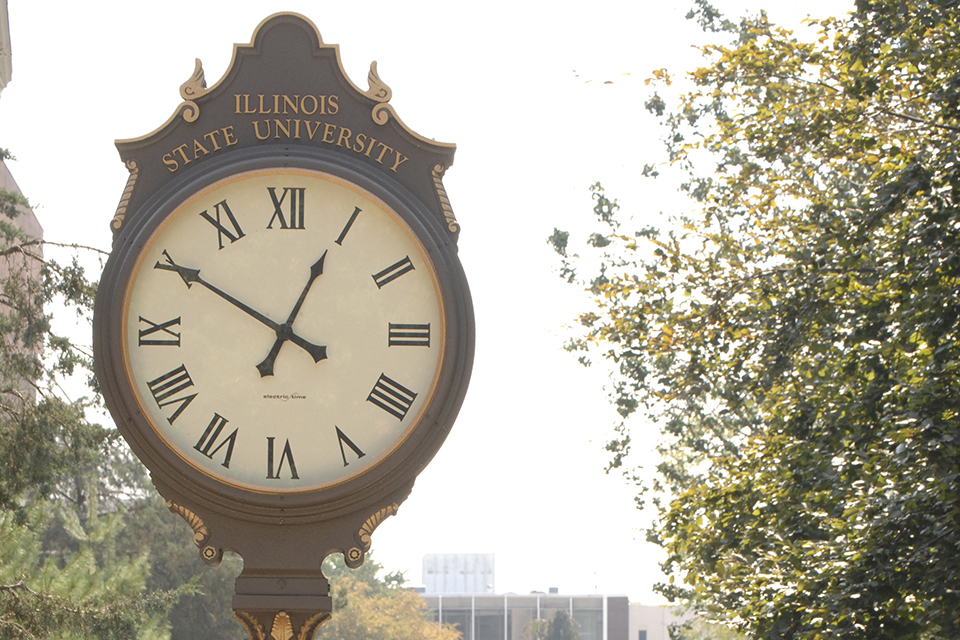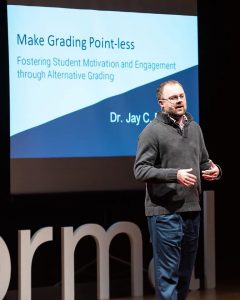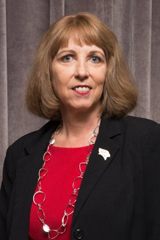When the pandemic hit in the spring, word came to faculty members that classes would be shifted online. For Assistant Professor of Teaching and Learning Jay Percell, that meant quickly plotting a new course for his students.
“With all of the newness and change students were no doubt facing from every corner of their lives, my goal was not to overwhelm them,” Percell said. He decided to adapt his classes to a combination of what is known as “synchronous” and “asynchronous” formats.
Synchronous courses meet at a scheduled time, with all students present (or in the case of online course, all logging into Zoom simultaneously). Asynchronous online courses do not require students to be at their computers and log in at a certain time. Course material is assembled by the instructor and posted for students to complete during the week. Often students connect via discussion boards or small-group work. Some course instructors use a hybrid approach, combining synchronous and asynchronous forms of instruction.
“We set up a schedule where we would meet synchronously on Mondays, work asynchronously on projects on Wednesdays, and submit assignments on Fridays,” said Percell. “I found it gave students structure in these times of uncertainty, but flexibility to have it work around their changing needs.”
Asynchronous courses are a relatively new style of instruction at ISU, noted Illinois State University Vice President of Academic Affairs and Provost Aondover Tarhule. “For many students, this approach is highly attractive and beneficial because it allows them to fit a course into a schedule that works for them while still giving them the option to engage fully with their instructors,” he said, adding that while asynchronous courses do not include real-time lectures, engagement continues. “Faculty have put considerable amount of time and planning in developing these courses. As a result, learning experiences and outcomes are comparable to in-person classes.”
As Illinois State moved a majority of classes online for fall instruction, a portion of them were set aside as asynchronous. Out of the nearly 4,000 classes happening online this fall, only around 20 percent are completely asynchronous, yet that small number can keep doors open for many students to keep learning.
“I’ve had students who live in homes where there is only one computer, which they and their parents who are working from home must share,” said Professor Julie Jung of the Department of English. “I know of others who are caregivers of children, elderly parents, and/or sick family members who can access the course materials only after these dependents’ needs have been met. Others live in rural areas where reliable WiFi does not exist. Others must work full-time jobs to help contribute to their family’s livelihood because their parents have lost jobs due to the pandemic.”
With asynchronous courses, students often discover a new-found autonomy over their learning. “One of my students said she realized quickly she needed to be a lot more proactive with her courses,” said Percell, who is remaining with the asynchronous/synchronous format for his classes this fall. “Often in-person classes are set up to have students be in a receiving role, and now students are going on the advance.”
Assistant Professor Kantara Souffrant, of the Wonsook Kim School of Art, worried about the ways she would help students build a community with asynchronous courses. Discussion boards she set up before class allowed students to share insights and worries that connected them. “If a student posted about being excited to learn about art from Africa and the African diaspora, someone else might post ‘Me too!’” she said. “My heart was really touched when they shared being nervous about things like time management, being fully online, and no longer being in the classroom. They were engaging with each other and affirming each other’s feelings.”
For her asynchronous classes, Assistant Professor Sarah Boesdorfer begins her courses with introductions, which she envisions elicit the same groans as ice-breakers on the first day of an in-person class. “It might seem simple, but it is a way to make a connection,” said Boesdorfer. “Those connections help students later when they need to give one another feedback on projects and on work.”
When universally designed—or designing courses or programs with every student in mind—the asynchronous format enhances the University’s core values of individualized attention as well as diversity and inclusion. “Asynchronous classes that are universally designed can meet students’ diverse learning styles,” said Student Access and Accommodation Services Director Tammie Keney. “Students that may need an accommodation due to disability may be able to self-accommodate in many instances when courses are designed well.”
Instructors across campus can find resources for continuing to hone asynchronous courses through the Center for Teaching, Learning, and Technology, and through the Redbirds Keep Teaching page on the coronavirus website. A similar resource, Redbirds Keep Learning, is also available on that site to support student success in online environments.







